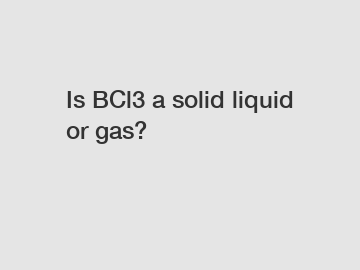Is BCl3 a solid liquid or gas?
When it comes to the molecular compound BCl3, many people may wonder whether it exists as a solid, liquid, or gas at room temperature. The answer to this question lies in the unique properties of the compound and its behavior under different conditions.
BCl3, also known as boron trichloride, is a colorless, toxic gas that has a pungent odor. It is composed of one boron atom and three chlorine atoms, bonded together through covalent bonds. This molecule has a trigonal planar shape, with the boron atom at the center and the three chlorine atoms arranged symmetrically around it.
One of the key factors determining the physical state of a compound is its melting and boiling points. For BCl3, the melting point is -107.30 degrees Celsius, and the boiling point is -85.0 degrees Celsius. These values indicate that BCl3 is a gas at room temperature (around 25 degrees Celsius).

The low melting and boiling points of BCl3 can be attributed to the weak intermolecular forces present between its molecules. In the case of BCl3, the primary intermolecular forces are van der Waals forces or London dispersion forces. These forces are relatively weak compared to other types of intermolecular interactions, such as hydrogen bonding or dipole-dipole interactions. As a result, BCl3 molecules have low attraction to each other, allowing them to move freely and exist as a gas at room temperature.
In addition to its physical state, the chemical properties of BCl3 also play a role in determining its behavior. BCl3 is a Lewis acid, meaning that it can accept electron pairs from Lewis bases to form coordinate covalent bonds. This property makes BCl3 a versatile reagent in organic synthesis and other chemical reactions.
When exposed to water, BCl3 reacts to form hydrochloric acid (HCl) and boric acid (H3BO3). This reaction further highlights the volatile nature of BCl3 and its tendency to exist as a gas in most environments. However, under certain conditions, BCl3 can also form complexes with Lewis bases, leading to the formation of solid or liquid compounds.
Overall, BCl3 is primarily a gas at room temperature due to its low melting and boiling points and weak intermolecular forces. Its molecular structure and chemical properties contribute to its volatile nature and ability to exist in the gas phase.
In conclusion, the molecular compound BCl3 is a gas at room temperature, with a boiling point of -85.0 degrees Celsius. Its low melting and boiling points, weak intermolecular forces, and chemical properties as a Lewis acid all contribute to its gas-like behavior. While BCl3 can form solid or liquid compounds under certain conditions, it is most commonly found in the gaseous state. Understanding the physical and chemical properties of BCl3 can provide valuable insights into its behavior and applications in various fields.
If you want to learn more, please visit our website trifluoromethane gas, bf3 melting point, specialty gas products.


